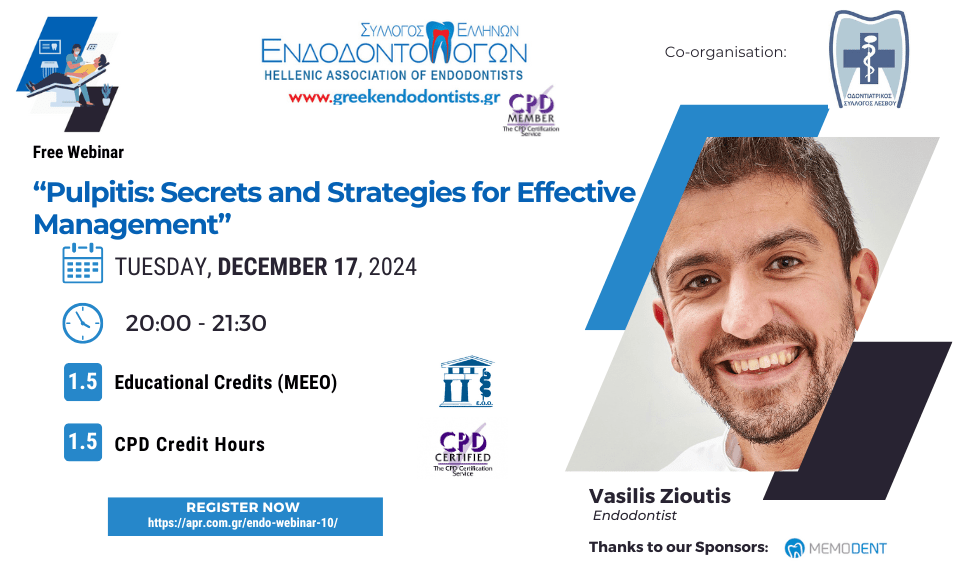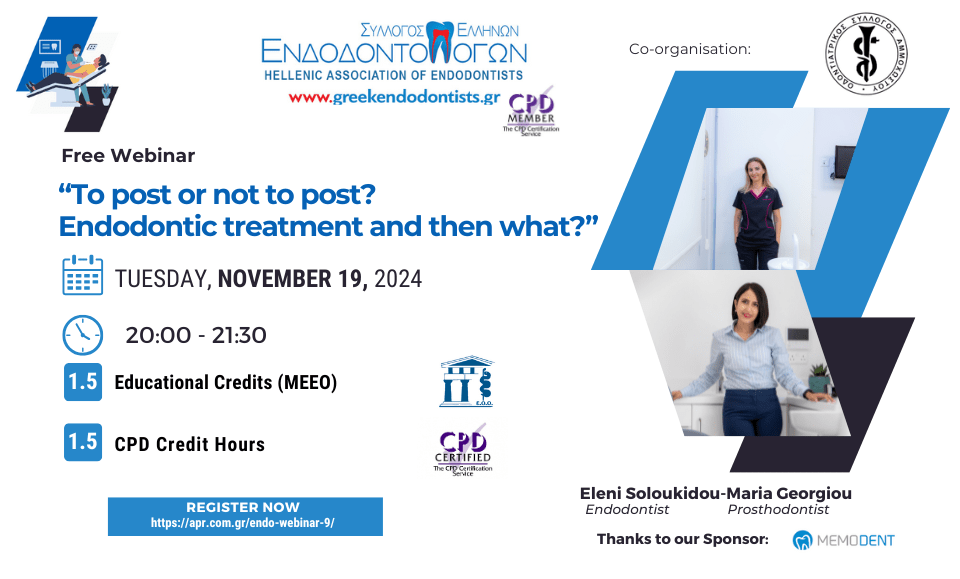Resolving the puzzle of diagnosis in Endodontics
Informations
Dear Colleagues, Our next webinar is scheduled for Tuesday 25/01/2022 at 20:00. During this webinar our speaker, Endodontist Sakka Dimitra will be covering the topic “Resolving the puzzle of diagnosis in Endodontics”. This webinar is a collaboration of the Hellenic Association of Endodontists and the Dental Association of Kilkis. Attendees will be credited 1,5 CE credits (MEEO) as well as 1,5 CPD Credit Hour. The language of the webinar will be Greek.
Days
Hours
Minutes
Seconds
WEBINAR SPONSOR


Abstract
The diagnostic approach to pulpal and periapical disease is usually a complex process, that requires combination analysis of symptoms and radiographic findings. Endodontic diagnosis is similar to a jigsaw puzzle, as it cannot be made from a single isolated piece of information. The clinician must systematically gather all of the necessary information to make a “probable” diagnosis. The clinical and radiographic examinations in combination with a thorough periodontal evaluation and clinical testing (pulp and periapical tests) are prerequisite in order to confirm the preliminary diagnosis. In some cases, the clinical and radiographic examinations give conflicting results specific diagnoses cannot be made. Treatment should not be rendered without a diagnosis and in these situations, we may have to wait and be reassessed at a later date. In particular, the diagnosis is based on data obtained from medical and dental history, responses to pulp sensibility tests and radiographic interpretation. Clinical examination and modern imaging techniques contribute significantly to the aforementioned goals. As part of this presentation, a brief reference to symptoms and signs of pulpal and periapical diseases and presentation of the modern classification of those diseases will be done. Well-defined radiolucent lesions surrounding teeth may present difficulties in differential diagnosis and in determining treatment strategies. There are some lesions that appear in periapical regions mimicking an endodontic lesion due to pulp necrosis. Most of them are developmental cysts, or odontogenic tumours, such as ameloblastoma or malignant lesions may also be found. Volume tomography with CBCT, when used in accordance with the current European Commission guidelines, is recommended for complex endodontic problems. In this webinar we will analyze step by step the diagnostic procedure in endodontics, as well as complex diagnostic cases. We will also learn which medical conditions may present with dental or orofacial pain, and how we can reach to the right diagnosis and treatment.
Short CV
Sakka Dimitra
I was born in Karditsa in 1992. I obtained my undergraduate degree in National Kapodistrian University of Athens, School of Dentistry, Greece (2010-2015). Afterwards I worked as a general dentist while i was also an associate in the department of Endodontics at the University of Athens.

I completed my master's degree in Endodontics in the Aristotle University of Thessaloniki over a three-year full-time course (MSc). All these years she has been working as an endodontist and has also attended many international congresses and published research papers in scientific medical journals. The research field of my interest is “Regenerative Endodontics”. The subject of my thesis was "Comparative evaluation of the therapeutic potential of two platelet concentrates related to regenerative endodontics", which was published in the International Journal of Dentristry and Oral Health, March of 2020. Since 2020 I live in Athens and work as an associate endodontist with Dr Mary Paraskevopoulou in her private practice, limited to Endodontics.



